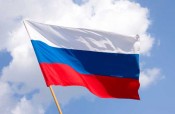
Presidential Library marks 30th anniversary of celebration of National Flag Day of the Russian Federation
30 years ago, in August 1994, the Day of the National Flag of the Russian Federation was officially established by Presidential Decree. Since then, the holiday has been celebrated annually on August 22th.
The history of the Russian national flag dates back to the Middle Ages. There is a brief note on old Russian banners by Lieutenant Commander Peter Belavents in the materials of a special meeting organized by the Ministry of Justice to clarify the issue of Russian state colors. He writes that banners and flags before Peter's time were divided into those of great sovereigns, great regiments, and hundreds. The most significant were the so-called great sovereign banners, which came closest to the current flag in terms of importance, as they indicated the presence of the sovereign. One of the most notable examples is the banner used by Grand Duke Dmitry Donskoy at the Battle of Kulikovo in 1380.
The only thing that can be said with certainty about this banner is that it was large and had the image of "the image of the Uncreated Savior". The exact dimensions of the banner are unknown, but it was probably in the shape of a kerchief.
The need for a state banner arose under Tsar Alexei Mikhailovich, the father of Peter the Great. For the first time, white, blue, and red colors were used for the flag when the first Russian warship, "Eagle", was launched in 1668.
At the beginning of his reign, Peter I strictly followed the traditions established by his father. During the Great Embassy to Europe, a long and detailed instruction was written on what to do. One of the tasks of the embassy was to purchase white, blue, and red garusses for sea flags.
On January 20, 1705, Peter the Great issued a decree ordering the adoption of a new flag for merchant ships, consisting of three horizontal stripes of white, blue, and red. The tsar personally drew the design and determined the order of the stripes. This tricolored flag became a symbol of commercial activity, alongside the personal standard of the emperor and other flags used by various branches of the military.
Under Peter the Great, the white, blue, and red colors were incorporated into various forms. For instance, officers of the Life Guard of the Preobrazhensky Regiment used tricolor scarfs as distinguishing signs. After 1700, the St. Andrew's Flag was adopted in the navy, replacing the tricolored one. In 1720, Peter prescribed that the merchant and commercial vessels fly the white, blue, red flag.
The transformation of the tricolor flag into a national symbol was a gradual process.
In 1896, just before the coronation of Nicholas II, the white, blue, and red flag was officially designated as the only national flag of the Russian Empire. At that time, the three colors on the flag were given official meanings. White symbolized freedom and independence, blue represented the Mother of God who protected Russia, and red stood for sovereignty. Another interpretation of the colors was the Commonwealth of White, Little, and Great Russia.
In 1918, the Red Flag became the state symbol of the RSFSR and, in 1922, of the USSR. In 1991, on August 22nd, the Extraordinary Session of the Supreme Soviet of the RSFSR restored the Tricolor as the official flag of Russia. On December 11th, 1993, the Decree of the President of the Russian Federation approved the Regulations on the National Flag of Russia. Later, on August 20th, 1994, President signed a decree declaring the Day of the National Flag.
Nowadays, the colors of the flag have no official interpretation, although it is commonly believed that white stands for peace, purity and perfection; blue for faith and fidelity; and red for energy, strength and the blood shed for one's country.
For more information about the history of the Russian Tricolor visit the Presidential Library's portal, for example the Symbols of State Authority section of the State Authority collection, as well as in the On this Day section.

